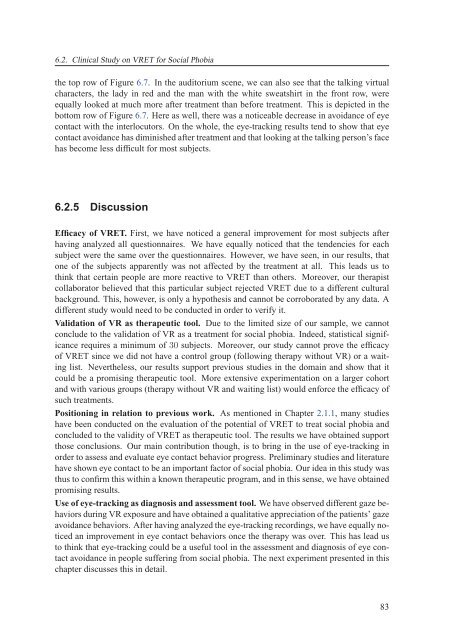Texte intégral / Full text (pdf, 20 MiB) - Infoscience - EPFL
Texte intégral / Full text (pdf, 20 MiB) - Infoscience - EPFL
Texte intégral / Full text (pdf, 20 MiB) - Infoscience - EPFL
Create successful ePaper yourself
Turn your PDF publications into a flip-book with our unique Google optimized e-Paper software.
6.2. Clinical Study on VRET for Social Phobia<br />
the top row of Figure 6.7. In the auditorium scene, we can also see that the talking virtual<br />
characters, the lady in red and the man with the white sweatshirt in the front row, were<br />
equally looked at much more after treatment than before treatment. This is depicted in the<br />
bottom row of Figure 6.7. Here as well, there was a noticeable decrease in avoidance of eye<br />
contact with the interlocutors. On the whole, the eye-tracking results tend to show that eye<br />
contact avoidance has diminished after treatment and that looking at the talking person’s face<br />
has become less difficult for most subjects.<br />
6.2.5 Discussion<br />
Efficacy of VRET. First, we have noticed a general improvement for most subjects after<br />
having analyzed all questionnaires. We have equally noticed that the tendencies for each<br />
subject were the same over the questionnaires. However, we have seen, in our results, that<br />
one of the subjects apparently was not affected by the treatment at all. This leads us to<br />
think that certain people are more reactive to VRET than others. Moreover, our therapist<br />
collaborator believed that this particular subject rejected VRET due to a different cultural<br />
background. This, however, is only a hypothesis and cannot be corroborated by any data. A<br />
different study would need to be conducted in order to verify it.<br />
Validation of VR as therapeutic tool. Due to the limited size of our sample, we cannot<br />
conclude to the validation of VR as a treatment for social phobia. Indeed, statistical significance<br />
requires a minimum of 30 subjects. Moreover, our study cannot prove the efficacy<br />
of VRET since we did not have a control group (following therapy without VR) or a waiting<br />
list. Nevertheless, our results support previous studies in the domain and show that it<br />
could be a promising therapeutic tool. More extensive experimentation on a larger cohort<br />
and with various groups (therapy without VR and waiting list) would enforce the efficacy of<br />
such treatments.<br />
Positioning in relation to previous work. As mentioned in Chapter 2.1.1, many studies<br />
have been conducted on the evaluation of the potential of VRET to treat social phobia and<br />
concluded to the validity of VRET as therapeutic tool. The results we have obtained support<br />
those conclusions. Our main contribution though, is to bring in the use of eye-tracking in<br />
order to assess and evaluate eye contact behavior progress. Preliminary studies and literature<br />
have shown eye contact to be an important factor of social phobia. Our idea in this study was<br />
thus to confirm this within a known therapeutic program, and in this sense, we have obtained<br />
promising results.<br />
Use of eye-tracking as diagnosis and assessment tool. We have observed different gaze behaviors<br />
during VR exposure and have obtained a qualitative appreciation of the patients’ gaze<br />
avoidance behaviors. After having analyzed the eye-tracking recordings, we have equally noticed<br />
an improvement in eye contact behaviors once the therapy was over. This has lead us<br />
to think that eye-tracking could be a useful tool in the assessment and diagnosis of eye contact<br />
avoidance in people suffering from social phobia. The next experiment presented in this<br />
chapter discusses this in detail.<br />
83

















